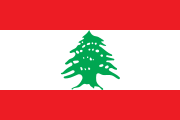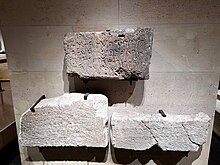
Back بوابة:لبنان Arabic بوابة:لبنان ARZ Portail:Liban French Portale:Libano Italian Portal:Lubnan Malay Portal:Líbano Portuguese Портал:Ливан Russian باب:لبنان Urdu Cổng thông tin:Liban Vietnamese
The Lebanon PortalA view of Byblos, Lebanon
 Lebanon (/ˈlɛbənɒn, -nən/ LEB-ə-non, -nən; Arabic: لُبْنَان, romanized: Lubnān, local pronunciation: [lɪbˈneːn]), officially the Republic of Lebanon, is a country in the Levant region of West Asia. It is bordered by Syria to the north and east, by Israel to the south, and by the Mediterranean Sea to the west; Cyprus lies a short distance away from the country's coastline. Lebanon's location at the crossroads of the Mediterranean Basin and the Arabian hinterlands has contributed to the country's rich history and shaped a unique cultural identity shaped by religious diversity. Lebanon has a population of more than five million people and covers an area of 10,452 square kilometres (4,036 sq mi). Lebanon's capital and largest city is Beirut, followed by Tripoli and Jounieh. While Arabic is the official language, French is also recognized in a formal capacity; Lebanese Arabic is the country's vernacular, though French and English play a relatively significant role in everyday life, with Modern Standard Arabic being limited to news and government matters. The earliest evidence of human civilization in Lebanon dates back to 5000 BCE. From 3200 to 539 BC, what was to become Lebanon was part of Phoenicia, a maritime empire that stretched the Mediterranean Basin. In 64 BC, the Roman Empire conquered the region, and Lebanon soon became a major center for Christianity under the aegis of the Byzantine Empire. In the 7th century, the Muslim conquest of the Levant brought the region under the control of the Rashidun Caliphate. The 11th century saw the beginning of the Crusades and the establishment of Crusader states, which later fell to the Ayyubids and the Mamluks, who in turn ceded the territory to the Ottoman Turks in the aftermath of the Ottoman–Mamluk War of 1516–1517. Under Ottoman ruler Abdulmejid I, the first Lebanese proto-state was established in the form of the Mount Lebanon Mutasarrifate, created in the 19th century as a home for Maronite Christians under the Ottoman "Tanzimat" period. Lebanon is a developing country, ranked 112th on the Human Development Index. It has been classified as an upper-middle-income state. The Lebanese liquidity crisis, coupled with nationwide corruption and recent disasters such as the 2020 Beirut explosion, have precipitated the collapse of Lebanon's currency and fomented political instability, widespread resource shortages, and high unemployment and poverty. The World Bank has defined Lebanon's economic crisis as one of the world's worst since the 19th century. Despite the country's small size, Lebanese culture is renowned both in the Arab world and globally, powered primarily by the Lebanese diaspora. Lebanon is a founding member of the United Nations and of the Arab League, and is a member of the Non-Aligned Movement, the Organization of Islamic Cooperation, the Organisation internationale de la Francophonie, and the Group of 77, among others. (Full article...) This is a Featured article, one of the best articles Wikipedia has to offer.
 Bodashtart (also transliterated Bodʿaštort, meaning "from the hand of Astarte"; Phoenician: 𐤁𐤃𐤏𐤔𐤕𐤓𐤕) was a Phoenician ruler, who reigned as King of Sidon (c. 525 – c. 515 BC), the grandson of King Eshmunazar I, and a vassal of the Achaemenid Empire. He succeeded his cousin Eshmunazar II to the throne of Sidon, and scholars believe that he was succeeded by his son and proclaimed heir Yatonmilk. Bodashtart was a prolific builder, and his name is attested on some 30 eponymous inscriptions found at the Temple of Eshmun and elsewhere in the hinterland of the city of Sidon in Lebanon. The earliest discovered of Bodashtart's inscriptions was excavated in Sidon in 1858 and was donated to the Louvre. This inscription dates back to the first year of Bodashtart's accession to the throne of Sidon and commemorates the building of a temple to the goddess Astarte. The Temple of Eshmun podium inscriptions were discovered between 1900 and 1922 and are classified into two groups. The inscriptions of the first group, known as KAI 15, commemorate building activities in the temple and attribute the work to Bodashtart. The second group of inscriptions, known as KAI 16, were found on podium restoration blocks; they credit Bodashtart and his son Yatonmilk with the construction project and emphasise Yatonmilk's legitimacy as heir. The most recently discovered inscription as of 2020 was found in the 1970s on the bank of the Bostrenos River, not far from the Temple of Eshmun. The inscription credits the King with the building of water canals to supply the temple in the seventh year of his reign. Three of Bodashtart's Eshmun temple inscriptions have been left in place; the others are housed in museums in Paris, Istanbul, and Beirut. Bodashtart is believed to have reigned for at least seven years, as evidenced by the Bostrenos River bank inscription. Little is known about his reign other than what has been learned from his dedicatory inscriptions. (Full article...)Did you know (auto-generated) -
TopicsRelated portalsReligions in Lebanon Arab states This is a Good article, an article that meets a core set of editorial standards.
 General imagesThe following are images from various Lebanon-related articles on Wikipedia.
CategoriesAssociated WikimediaThe following Wikimedia Foundation sister projects provide more on this subject:
SourcesDiscover Wikipedia using portals |
© MMXXIII Rich X Search. We shall prevail. All rights reserved. Rich X Search





















































